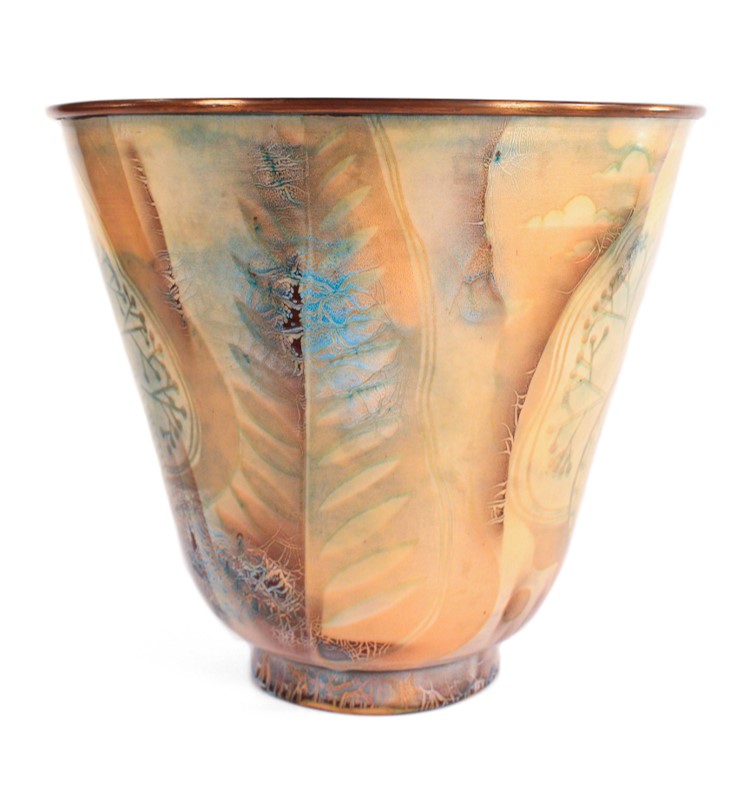Born in Pasadena, California, Edward Winter (1908-1976) moved to Cleveland, Ohio in 1911, eventually becoming a predominant figure in the city’s art scene and a pioneer in enameling techniques throughout the United States. Winter studied decorative design at what is now known as the Cleveland Institute of Art. While in college, he met his future wife, fellow artist, and frequent collaborator, Thelma Frazier (1903-1977) whom he married in 1939. Shortly after graduating in 1931, Winter traveled to Vienna where he studied metalwork and enameling with Josef Hoffmann (1870-1956), a German architect, and ceramics with Michael Powolny (1871-1954), an Austrian sculptor and ceramist who taught many ceramic luminaries of the time, including Viktor Schreckengost (1906-2008), Edris Eckhardt (1905-1998), and Russell Aitken (1910-2002). A year later, Winter returned to Cleveland with a keen interest in enameling and architectural design. In 1932, Winter met Robert A. Weaver, president of the Ferro Enamel Corporation of Cleveland. Weaver granted Winter access to the company’s industrial-sized furnace after business hours. This arrangement, which continued throughout his long career, allowed Winter to experiment with large-scale enameling, leading him to revolutionize enameling throughout the United States. Enameling is a process in which colorful glass or a glass-like substance is applied and fused to metal. Although enameling on metal dates back to the Ancient Greeks and Romans in the fourth and fifth centuries B.C.E., Winter resuscitated enameling on copper and made it popular in the early 1930s. At this time, refrigerators and stoves often had white enameled sides, and this led Winter to a new idea: enamel murals. Winter designed and painted the first enamel mural in the United States in 1934 for Weaver’s Ferro Enamel Corporation. In addition to his artistic works, Winter also specialized in functional enamels and sold enamel dishware commercially. His company was one of the few luxury businesses to grow during the Great Depression. Winter’s studies in Vienna proved fruitful and with access to Ferro Enamel Corporation’s supplies, he met with almost immediate success. In 1933, not long after his return to Cleveland, Winter won first prize for ten enamels in the Cleveland Museum of Art’s May Show. In the same year, he was featured in the Second Ceramic National at the Syracuse Museum of Fine Arts, today the Everson Museum. His work continued to be exhibited regularly in the Ceramic Nationals for decades. Winter’s Fruits of Plenty joined the Everson’s collection in 1937, when it won the Purchase Prize in the Sixth Ceramic National. Fruits of Plenty showcases one of Winter’s revolutionary techniques, which he called crazing or crackling. To create the crackling effect, Winter discovered that he could apply a hard enamel on top of a soft enamel. Because the first layer of enamel was soft and melted more quickly, it pulled on the second layer as the object was fired, creating crackling on the object’s surface. Winter applied this technique to the interior rim of Fruits of Plenty, creating beautiful veins of brown on white. He used stenciling to decorate the sides of the vase by sifting powered enamel on top of stencils affixed to the vase’s surface. Fruits of Plenty is currently on view in A Legacy of Firsts: The Everson Collects, an exhibition that examines over one hundred years of the Museum’s collecting priorities, from the Museum’s earliest acquisitions in 1911 to work acquired in 2019. A Legacy of Firsts is on view through March 22, 2020.
-Mónica Quiñones-Rivera, Curatorial Intern
Sources:Boram-Hays, Carol. Bringing Modernism Home: Ohio Decorative Arts, 1890-1960. Athens, OH: Ohio University Press, 2005. Jazzar, Bernard N. and Harold B. Nelson. Painting with Fire: Masters of Enameling in America, 1930-1980. Long Beach, CA: Long Beach Museum of Art, 2006.


